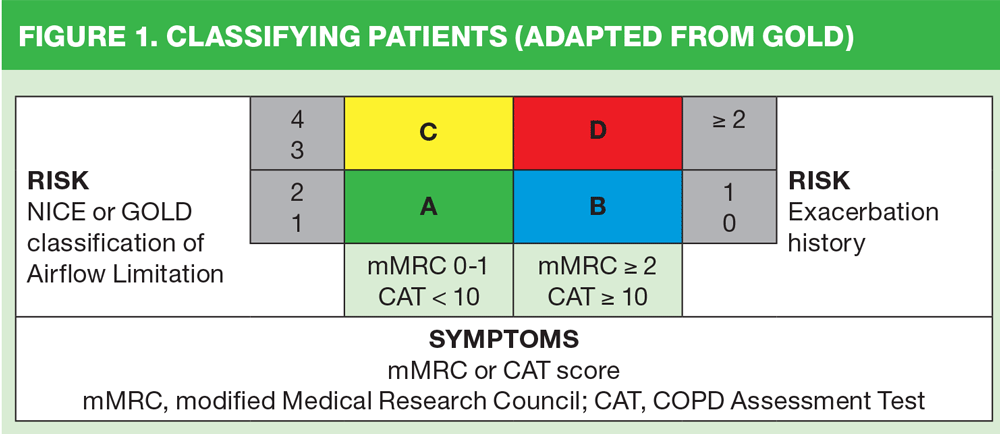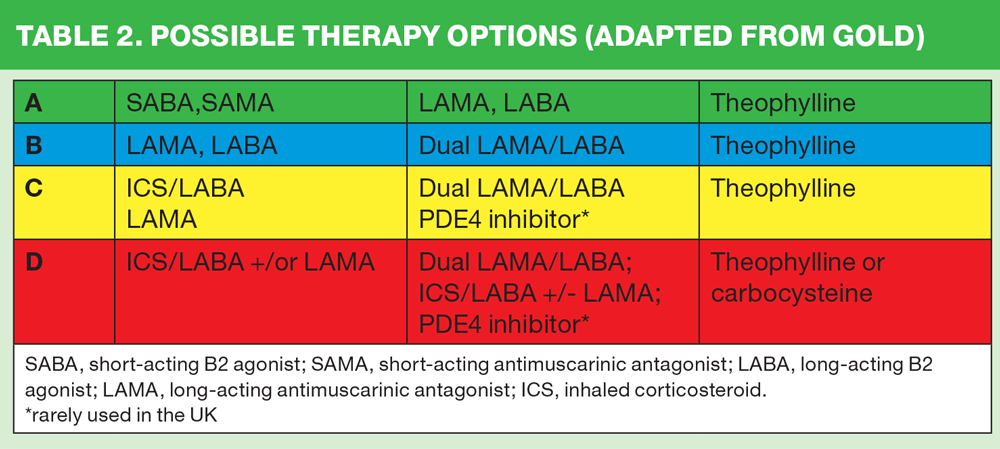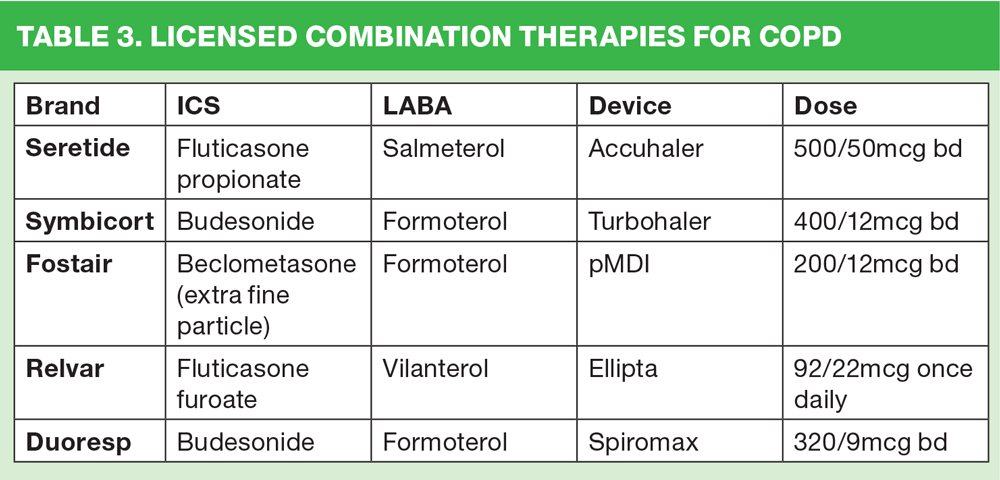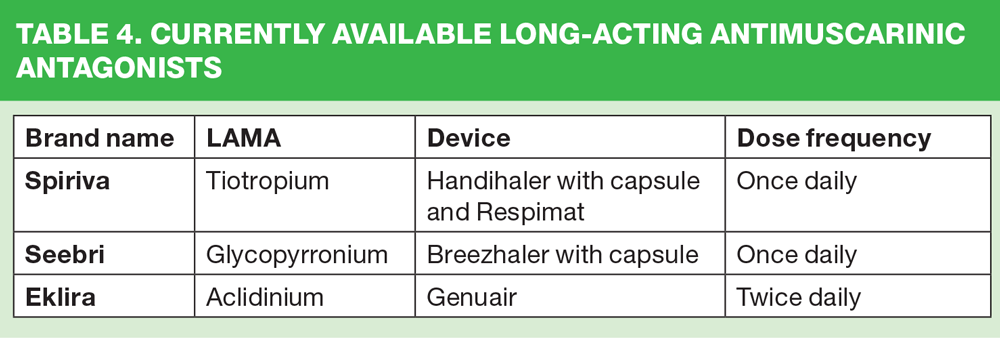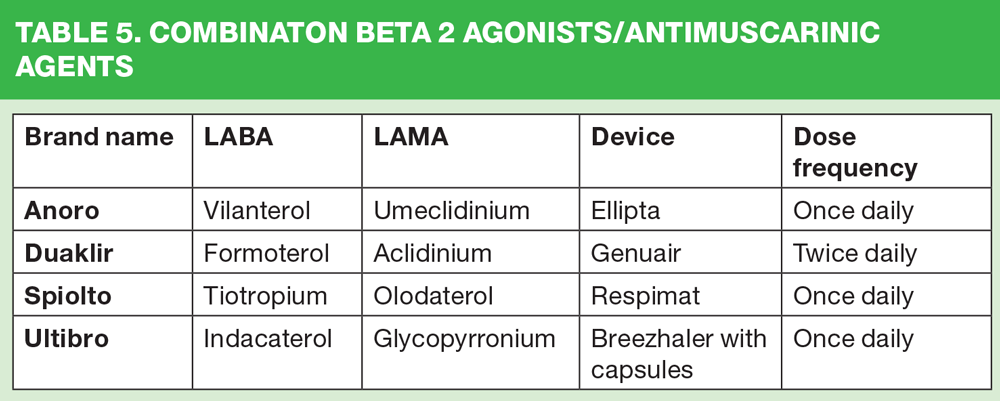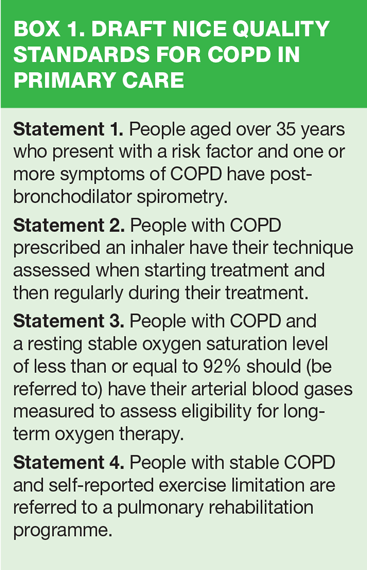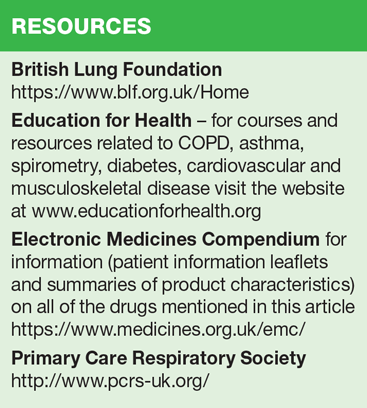
COPD masterclass: Keeping pace with chronic obstructive pulmonary disease
Beverley Bostock-Cox
Beverley Bostock-Cox
RGN, MSc, QN
Nurse Practitioner Mann Cottage Surgery Moreton in Marsh
Clinical Lead Education for Health Warwick
Our understanding of COPD is a rapidly evolving area, and current thinking has moved on since the NICE guideline was published five years ago. We bring you right up to date with an overview of the latest management strategies and treatment options
In 2010 the National Institute for Health and Care Excellence (NICE) published its guidance on the diagnosis and management of chronic obstructive pulmonary disease (COPD).1 Since then, new evidence and guidelines have emerged which have changed the way we think about this condition – from dealing with its causes to the treatment options which should be offered. In this article we will consider the latest thinking on the prevention, diagnosis and management of COPD.
OBJECTIVES
By the end of this article you should be able to
- Evaluate new approaches to the prevention of COPD through smoking cessation
- Identify best practice in the diagnosis of COPD
- Differentiate between different phenotypes in COPD
- Recognise how to match treatment options to individuals in line with national and international guidelines
- Review how your practice implements the NICE quality standards for COPD
DEFINITION
NICE defines COPD as being caused by ‘progressive, irreversible airflow obstruction which varies little over time’.1 The Global Initiative for Chronic Obstructive Lung Disease (GOLD) guideline describes COPD as ‘persistent, progressive airflow limitation which is associated with a chronic inflammatory response in the airways and the lungs’.2 COPD is an incurable condition which is the cause of distressing symptoms, such as breathlessness and cough and is the fifth leading cause of death in the UK.3 It also has significant resource implications for the NHS, primarily due to admissions for exacerbations.4 Therefore, the importance of correct diagnosis, treatment and management cannot be overstated.
MAKING THE DIAGNOSIS
A structured approach to diagnosing COPD should be taken using a combination of history taking and investigations.5 While taking a good history is the most important element, there is a clear need for quality assured diagnostic spirometry (QADS) to confirm the diagnosis.6 National guidelines on QADS state unequivocally that spirometry should be carried out by competent and qualified staff as poor quality spirometry, both in terms of performance and interpretation, can result in misdiagnosis.7 While it is not mandatory to be on the Association of Respiratory Technicians and Physiologists (ARTP) register to perform spirometry, the guidelines recommend it, meaning that people carrying out or interpreting spirometry without the qualification place themselves at medico-legal risk.6 Clinicians need to recognise when spirometry has been performed incorrectly in order to avoid interpreting a poor quality trace. Once all parameters have been checked and the trace has been found to meet the standards required for QADS, the diagnosis can be made with confidence. The presence of irreversible, post-bronchodilator airflow obstruction in a person with symptoms of COPD confirms the diagnosis. However, if the patient fails to respond to treatment, the diagnosis should be revisited.
SMOKING, HELPING PEOPLE QUIT AND E-CIGARETTES
There are several possible causes of COPD, most of which include exposure to ‘noxious particles’ but the predominant cause in the western world is cigarette smoking.8 Advice on avoidance of smoking or smoking cessation is an important part of the role of general practice nurses (GPNs) and GPNS should familiarise themselves on the recent guidance from Public Health England (PHE), which is the first official endorsement of e-cigarettes in the smoking cessation portfolio.9 There has been a huge rise in the numbers of people ‘vaping’ as a means of reducing or quitting smoking and this guidance suggests that e-cigarettes may be 95% safer than normal cigarettes. Nonetheless, research into these products is still ongoing and until regulation happens in May 2016, there is no standardisation of products for vaping, making it harder to generalise about safety. It may be no coincidence that the numbers of people accessing smoking cessation support services is presently at a low level.10 It may be that the reluctance of health care professionals to engage with smokers using e-cigarettes as a means to quit has led to people going it alone. Although the PHE advice gives a new slant to the NHS’s response to vaping, it is important to remember that there are tried and tested, evidence-based approaches to smoking cessation available including nicotine replacement therapy, varenicline and bupropion.11
TREATMENT OPTIONS: NEW APPROACHES, NEW THERAPIES
Many local guidelines and formularies are based on the national guidance on the use of inhaled therapies from NICE (Table 1) so it is worth considering whether recommendations that are 5 years old are still relevant now.
The international GOLD guidelines2 take a different approach to managing COPD (Figure 1, Table 2) and clinicians may need to consider where these publications differ and how that might affect their approach to advising patients about their treatment options.
NICE bases its advice on the use of inhaled therapies on lung function and symptoms, including persistent breathlessness and/or exacerbations. The usual approach would be to offer a short acting bronchodilator such as a beta2 agonist on an ‘as required’ basis in most cases but to tailor other therapies to the needs of the individual. For example, if a patient feels they will need to use their short-acting beta2 agonist regularly, a long-acting bronchodilator may also be indicated. This could be either a long acting beta2 agonist or a long acting muscarinic antagonist (LAMA). NICE also suggests that people with an FEV1 of less than 50% of predicted who are suffering from ‘exacerbations or persistent breathlessness’ might be considered for a combination inhaler containing an inhaled corticosteroid (ICS) and long acting beta2 agonist (LABA). In the same box of the NICE algorithm where an ICS/LABA is recommended for people who fit this profile, it states that dual LABAs and LAMAs should not be offered unless the person concerned declines an ICS/LABA or is unable to tolerate it.
This is in direct contrast to the GOLD ‘ABCD’ algorithm which advises clinicians to use the individual’s mMRC (modified Medical Research Council) or CAT (COPD Assessment Test) score along with the number of exacerbations to determine whether a short acting reliever, long acting bronchodilator, ICS/LABA combination inhaler, dual bronchodilator or even triple therapy (ICS/LABA plus a LAMA) should be used. This approach recognises that COPD is not a homogenous condition and that under this umbrella title hide different hues of the disease. For some people, symptoms such as breathlessness are the most problematic part of the diagnosis. For others, frequent exacerbations (two or more per year) limit their quality of life and increase the rate of loss of lung function and the risk of dying.12 The Evaluation of COPD Longitudinally to Identify Predictive Surrogate End-Points (ECLIPSE) study highlighted the fact irrespective of the severity of COPD, the strongest predictor of future exacerbation risk was a previous history of exacerbation.13
Identifying which type of COPD the patient has can help balance the benefits and drawbacks of different therapeutic approaches. For example, although inhaled steroids are known to have a range of potential side effects, the evidence for ICS/LABA combinations is strongest in people who have two or more exacerbations in a year,14 so people who suffer two or more exacerbations in a 12 month period may have the most to gain and the least to lose from using an ICS/LABA combination.
Decisions as to which ICS/LABA to use should be made based on a number of factors, not least the device. Patient ability to use the device is arguably the most important factor but it is important to make sure that the ICS/LABA and device are both licensed to use in COPD as this is not the case with all combination inhalers. In COPD correct inhaler technique leads to improved symptoms and reduces the risk of exacerbations.15 Licensed combinations for COPD are listed in Table 3.
People who are predominantly breathless, however, would have less to gain from an ICS/LABA and would benefit more from using a single or dual bronchodilator. There is a range of long acting beta2 agonists available (salmeterol, formoterol, indacaterol and olodaterol) in different devices including pMDIs, soft mist inhalers and dry powder inhalers (DPIs) and GPNs should ensure that they are familiar with these drugs and devices if they are to take a personalised approach to treatment. The currently available LAMAs are given in Table 4.
As a result of renewed interest in the potential benefits of optimising bronchodilation, using beta2 agonist drugs and antimuscarinic agents together,16 there has been an influx of these products onto the market (Table 5).
The challenge for the clinician, then, is to firstly decide which guidelines seem most appropriate for their patient and which category the individual patient belongs to, based on either the NICE algorithm or the GOLD ABCD classification system. Once this has been determined, the discussion as to which drug and device should be used can begin.
QUALITY STANDARDS IN PRACTICE
NICE has recently reviewed its quality standards for COPD and they are due for publication in January 2016.17 The main recommendations that affect primary care are listed in Box 1.
None of these primary care-specific standards should pose a challenge to primary care as they should all be happening already, but GPNs should consider whether they meet the suggested standards, perhaps by carrying out a simple audit, and put measures in place to address any shortcomings that are identified.
CONCLUSION
COPD is a condition which has a high cost in terms of symptoms, mortality and resources. Prevention should be a priority, and education about smoking avoidance and cessation advice as appropriate should be offered by all healthcare workers. Evidence based strategies for smoking cessation should be recommended but smokers who choose to use e-cigarettes should be supported to do so. People with risk factors and symptoms of COPD should have quality assured post bronchodilator spirometry carried out and interpreted by trained practitioners to confirm the diagnosis. Following diagnosis, treatment should be tailored to the individual based on national and international guidance and taking into account the risk: benefit ratio for each specific case. GPNs should be familiar with the extensive range of drugs and devices available and should be able to support patients to choose the treatment regimen which best suits them. This includes ensuring that patients can use their inhalers correctly. As well as providing pharmacological interventions, GPNs should be aware of the importance and benefits of non-pharmacological options, notably pulmonary rehabilitation.
REFERENCES
1. NICE CG101 Chronic Obstructive Pulmonary Disease (Update): full guidance, 2010. http://guidance.nice.org.uk/CG101/Guidance/pdf/English
2. Global Initiative for Chronic Obstructive Lung Disease (GOLD). Pocket guide to COPD diagnosis, management and prevention, 2015 http://www.goldcopd.org/uploads/users/files/GOLD_Pocket_2015_Feb18.pdf
3. Tidy C. Chronic Obstructive Pulmonary Disease, 2014. http://patient.info/doctor/chronic-obstructive-pulmonary-disease-pro
4. Department of Health. An outcomes strategy for people with chronic obstructive pulmonary disease (COPD) and asthma in England, 2011. https://www.gov.uk/government/publications/an-outcomes-strategy-for-people-with-chronic-obstructive-pulmonary-disease-copd-and-asthma-in-england
5. Bickley LS. Bates Guide to Physical Examination and History Taking. Philadelphia: Lippincott Williams and Wilkins; 2012
6. Primary Care Commissioning. A guide to performing quality assured diagnostic spirometry, 2013 https://www.pcc-cic.org.uk/sites/default/files/articles/attachments/spirometry_e-guide_1-5-13_0.pdf
7. Roberts NJ, et al. Why is spirometry underused in the diagnosis of the breathless patient: a qualitative study. BMC Pulmonary Medicine 2011;11:37
8. World Health Organization. Causes of COPD, 2015 http://www.who.int/respiratory/copd/causes/en/
9. 9. McNeill A et al (2015) E-cigarettes: an evidence update https://www.gov.uk/government/uploads/system/uploads/attachment_data/file/454516/Ecigarettes_an_evidence_update_A_report_commissioned_by_Public_Health_England.
10. HSCIC. Statistics on NHS Stop Smoking Services in England - April 2014 to March 2015 http://www.hscic.gov.uk/catalogue/PUB18002
11. NICE. Smoking cessation: supporting people to stop smoking, 2013. Quality statement 4: pharmacotherapy https://www.nice.org.uk/guidance/qs43/chapter/quality-statement-4-pharmacotherapy
12. Cote CG, Dordelly LJ, Celli BR. Impact of COPD exacerbations on patient centred outcomes. Chest 2007;131(3): 696–704
13. Hurst JR, et al for the Evaluation of COPD Longitudinally to Identify Predictive Surrogate End-points (ECLIPSE) investigators. Susceptibility to Exacerbation in Chronic Obstructive Pulmonary Disease N Engl J Med 2010;363:1128-1138
14. Nannini LJ, Lasserson TJ, Poole P. Combined corticosteroid and long-acting beta2-agonist in one inhaler versus long-acting beta2-gonists for chronic obstructive pulmonary disease. Cochrane Database of Systematic Reviews 2012, Issue 9. Available from http://www.ncbi.nlm.nih.gov/pubmedhealth/PMH0014169/
15. Lavorini F, Magnan A, Dubus JC, et al. Effect of incorrect use of dry powder inhalers on management of patients with asthma and COPD Respiratory Medicine 2008;102(4) 593-604
16. 16 Cazzola, M. and Molimard, M. The scientific rationale for combining long-acting beta2-agonists and muscarinic antagonists in COPD. Pulm Pharmacol Ther 2010;23:257–267
17. NICE. COPD Quality Standard Update (draft for consultation), 2015 http://www.nice.org.uk/guidance/indevelopment/gid-qsd122/consultation/chronic-obstructive-pulmonary-disease-qs-update-quality-standard-consultation
Related articles
View all Articles

